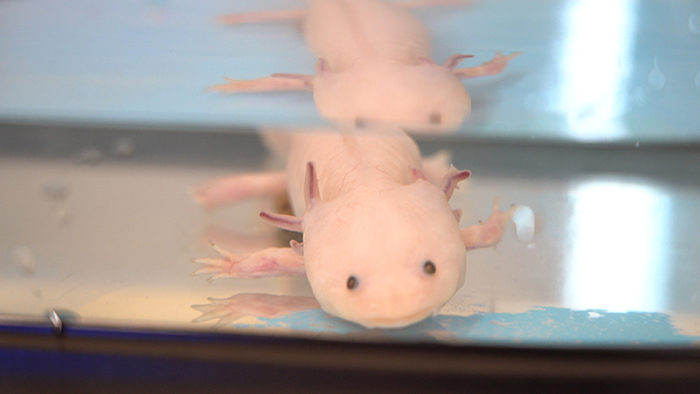Axolotls' regeneration after injury may be key to human brain health | SCMP
2022-09-09
 BGI Genomics scientists whose study of the axolotl’s ability to regenerate cells after
injury was published in Science journal say their findings have the potential
to help improve the regenerative capability of mammalian and human brains in
the future
BGI Genomics scientists whose study of the axolotl’s ability to regenerate cells after
injury was published in Science journal say their findings have the potential
to help improve the regenerative capability of mammalian and human brains in
the future
A team of BGI Genomics scientist has discovered a new subtype of neural stem cell that is key to brain regeneration in the axolotl, an animal capable of regrowing lost body parts.
The scientists said their research on the amphibian could potentially improve the regenerative capability of the brains of humans and other mammals in future.
The axolotl is an aquatic salamander able to regenerate cells in their brain, heart, limbs, spinal cord, tail, skin, jaw and muscle as well as the cornea, retina and lens of their eyes.
The researchers from Chinese company BGI Group, Wuhan University, Guangdong Provincial People’s Hospital and the Chinese Academy of Sciences said axolotls could restore lost cortical cell types in their brains after an injury.
“Axolotls may serve as a model for studying brain regeneration, possibly leading to discoveries that could be valuable for understanding the inherent limitations of brain regeneration in mammals and, ultimately, developing regenerative medicine for the central nervous system,” the team of researchers wrote in an article published in the peer-reviewed journal Science on Friday last week.
In the experiment, the scientists removed a piece of brain tissue from anaesthetised juvenile axolotls to generate brain damage. They then observed the recovery process with BGI Genomics Stereo-seq technology that reconstructs the axolotl brain architecture at single-cell resolution.
 Axolotls may serve as a
model for studying brain regeneration, says the team from BGI Group, Wuhan
University, Guangdong Provincial People’s Hospital and the Chinese Academy of
Sciences
Axolotls may serve as a
model for studying brain regeneration, says the team from BGI Group, Wuhan
University, Guangdong Provincial People’s Hospital and the Chinese Academy of
Sciences
Li Hanbo, a senior scientist at BGI Group and corresponding author of the study, said by phone that the most important discovery was a new subtype of neural stem cell called the reactive ependymoglial cell.
“It was transformed from quiescent ependymoglial cells [dormant neural stem cells], and stimulated by wound response,” Li said. “It was proliferated very fast after the incision in axolotl brains and was responsible for wound healing and reconstruction of the neuron network.”
They discovered the new subtype of neural stem cell in the damaged area after 15 days. After 20 to 30 days, they found new tissue had been regenerated, but with a significantly different cell type composition compared to the uninjured site.
Then, 60 days after the injury, the cell types and distribution at the wound site returned to the state of the non-injured tissue, the scientists found.
“Brain regeneration is a continuous process. We observed the regrowth of the tissue by around 20 to 30 days, but the neurons in the tissue were not fully functional – it might take another 30 days, depending on the body size of the axolotls,” Li said.
He said when the newly generated neurons were still immature, brain function might not be fully restored, meaning the animal might react more slowly and move less than usual.
In a phone interview, first author and BGI Group senior researcher Wei Xiaoyu said the ultimate research goal was to introduce stem cells to injured human brain tissue locally to restart any regeneration genes for recovery.
“Axolotls’ genome is 10 times bigger than that of humans but their coding genes are very similar to humans’. Humans may have the regeneration related genes but when we are injured we can’t activate the genes to regenerate the injured issues,” she said.
“In the next step of our regeneration research, we will study the brain regeneration model and find key regulatory elements in the axolotl’s genome, especially the transcription factors [proteins that bind to a specific DNA sequence and control the rate of transcription].
“After identifying key transcription factors in axolotls, we will perform experiments in mice to study if these factors can prompt tissue generation in them.”
Li said experimental trials in mice for organ regeneration could see major progress in the next few years, but technical preparation and safety evaluation for any potential human clinical applications would take longer.
“We need to be very cautious. It is not clear yet how it will be done. One possibility is to cultivate organs or tissues in vitro and transplant these into the human body for them to heal and recover their functions after the initial loss,” he said.
Source: South China Morning Post
About BGI Genomics
BGI Genomics, headquartered in Shenzhen China, is the world’s leading integrated solutions provider of precision medicine. In July of 2017, as a subsidiary of BGI Group, BGI Genomics (300676.SZ) was officially listed on the Shenzhen Stock Exchange.
BGI has topped the Asia Pacific and China life science corporate institution ranking table for the seventh year running, released in the 2022 Nature Index Annual Tables. Our services cover more than 100 countries and regions, involving more than 2,300 medical institutions.